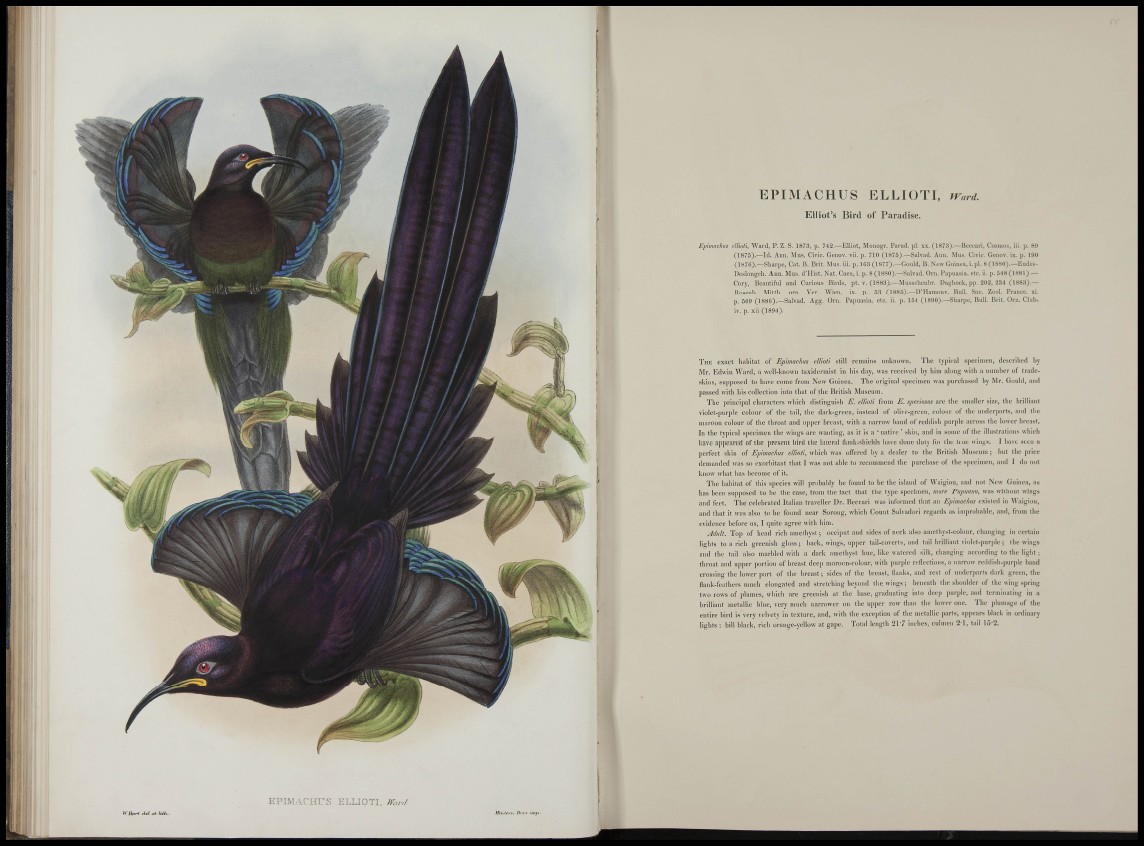
EPIMACHUS ELLIÜTI, Ward.
Elliot's Bird of Paradise.
Epmachis ellmti, Ward, P. Z. S. 1873, p. 742.—Elliot, Motiogr. Parad, pi. xx. (1873).—Beccarl, Cosmos, i'n. p. 8!l
(1875).—Id. Ann. Mus. Civic. Genov. vii. p. 710 (1875).—Salvad. Ami. Mus. Civic. Genov. ix. p. 190
(1876).—Sliarpe, Cat. B. Brit. Mus. iii. p. 1G3 (1877).—Gould, I!. New Guinea, i. pi. 8 (ISSO).—Eudes-
Deslongch. Ann. Mus. d'Hist. Nat. Caen,i. p. 8 (1880).—Salvad. Orn. Papuasia, etc. ii. p. 548(1881).—
Cory, Beautiful and Curious Birds, pt. v. (1883).—Musschenbr. Dagboek, pp. 202, 234 (1883).—
Rosenb. Mitth. orn. Ver. Wien, ix. p. 53 (1885).—D'Haraonv. Bull. Soc. Zool. France, xi.
p. 509 (1886).—Salvad. Agg. Orii. Papuasia, etc. ii. p. 154 (1890).—Shai pe, Bull. Brit. Orn. Club,
iv. p. xii (1894).
THE exact liabitat of Epimachus ellioti still remains unknown. Tiie ty|]ical specimen, described by
Mr. Edwin Ward, a well-Known taxidermist in liis day, was received by bim along with a number of tradeskins,
supposed to bave come from New Guinea. Tbe original s])ecimcn was jiurcbased by Mr. Gould, and
passed with liis collection into that of tbe British Museum.
Tbe ])rincipal cbaracters which distinguish E, ellioti from E. speciosus are tbe smaller size, the brilliant
violet-purple colour of tbe tail, the dark-green, instead of olive-green, colour of tbe undcrparts, and the
maroon colour of tbe throat and upper breast, witli a narrow band of reddish purple across the lower breast.
In tbe typical s)iecinien the wings are wantijig, as it is a ' native ' skin, and in some of tbe illustrations which
have appeared of tbe present bird the lateral llank-sbields have done duty for tbe true wings. I bave .seen a
])erfect skin of Epimmhus ellioti, wbicb was olTered by a dealer to tbe liritish Musenni; but tbe jirice
demanded was so exorbitant that I was imt able to recommend tlie purchase of tbe specijnen, and I do not
know what has become of it.
Tbe habitat of tbis species will probably be found to be the island of Waigiou, and not New Guinea, as
has been supposed to be the ease, from the fact that the lype sjiecimen, more Papmno, was without wings
and feet. Tbe celebrated Italian traveller Dr. Beecari was informed that an Epimachus existed in Waigion,
and that it was also to be foiind near Sorong, wliieb Count Salvadori regards as improbable, and, from tbe
evidcTice before us, I quite agree witb bim.
Adult. Top of bead rich ametbyst; occiput and sides of ncck also ametbyst-colonr, changing in certain
lights to a rich greenish gloss; back, wings, upper tail-coverts, and tail brilliant violet-purple; the wings
and the tail also marbled witb a dark ametbyst hue, like watered silk, changing according to the light;
throat and ujiper portion of breast deep maroon-colour, witb pur|)le rellections, a narrow reddisb-])urj)le band
crossing tbe lower part of the breast; sides of tbe breast, flanks, and rest of undcrparts dark green, tbe
llank-featliers much elongated and strctcbing beyond tbe wings; beneath the shoulder of tbe wing spring
two rows of ]ibimes, which are greenish at the base, graduating into deep purple, and terminating in a
brilliant metallic blue, very mucb narrower on the upper row than tbe lower one. The |ilumage of tbe
entire bird is very velvety in texture, and, witb the exception of tbe metallic parts, appears black in ordinary
lights : bill black, rich orange-yellow at gape. Total length 217 inches, eulnien 2-l, tail 1.5-2.
EPIMACHTS ELLIOTI,
yr tifrrt del ti lUh. . .Wríi.ií/rt ¿{f'«'.« imp.